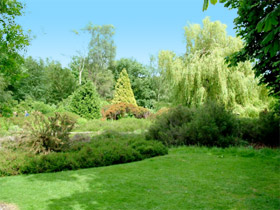
Richmond Park is a National Nature Reserve and London's largest Royal Park as well as the largest urban park in Europe. The park has an area of 2,500 acres and has been designated as a Site of Special Scientific Interest and a National Nature Reserve.
The Park has changed little over the centuries and, although it is surrounded by human habitation, the varied landscape of hills, woodland gardens and grasslands set among ancient trees abounds in wildlife.

The royal connections to this park probably go back further than any of the others, beginning with Edward I (1239-1307), when the area was known as the Manor of Sheen.
Richmond Park was established in its present form in 1625 by Charles I, who brought his court to Richmond Palace to escape the plague, turning the area on the hill above Richmond into a hunting park for red and fallow deer.
In 1637 Charles I enclosed the Park with high walls, an action that was not popular with the local residents, although he did allow pedestrians the right of way. To this day the walls remain, although they have been partially rebuilt and reinforced.
Legal action in 1758 by John Lewis, a public spirited brewer of Richmond, confirmed the right of access for pedestrians at all times and frustrated attempts by the Royal Ranger to prevent such access.
 The park has many woodland and areas of special interest. For example the Isabella Plantation is a stunning woodland garden, which was created after World War II from existing woodland, and is organically run, resulting in a rich flora and fauna.
The park has many woodland and areas of special interest. For example the Isabella Plantation is a stunning woodland garden, which was created after World War II from existing woodland, and is organically run, resulting in a rich flora and fauna.
The Park is also a top UK site for ancient trees, particularly oaks, which have great historic and wildlife importance. The trees and associated decaying wood support nationally endangered species of fungi, as well as a remarkable range of nationally scarce invertebrates such as the cardinal click beetle and the stag beetle. Over one thousand species of beetle (more than one quarter of the British list) have been recorded in the Park.